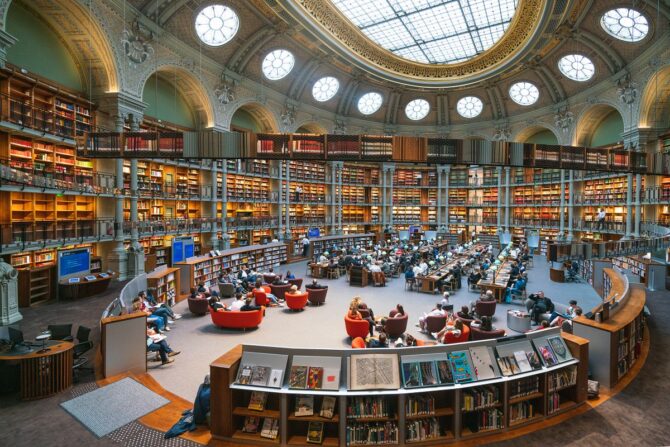10 Reasons to Visit the Bibliothèque Nationale de France’s Richelieu Palace in Paris
Sponsored

Located in the heart of Paris, behind the Palais Royal, the Richelieu palace is the historic location of the Bibliothèque Nationale de France (BNF) and houses the museum as well as a stunning reading room open to all.
1. A new museum to discover in Paris
Presenting over 900 exceptional pieces, from medallions and costumes to manuscripts, drawings, rare books maps, the new BNF museum, open in September 2022 after 12 years of restoration works, offers a chronological dive into the arts in France.

Galerie Mazarin © BnF
2. An architectural gem in the heart of Paris
As the historic cradle of the BNF, the Richelieu building is a marvel to visit in itself with stunning historic rooms to stroll through, including the Mazarin gallery, the Columns room or the Luynes room.

Façade de l’entrée Vivienne, ©Élie Ludwig_BnF
3. A one-hour tour of the history of France
Spread over 1,200m2, the museum explores the history of France through the collections of the royal family and the national library that established itself after the Revolution to do research. Some of the first archaeological scientific discoveries were made within the walls of the Richelieu building.

Salon Louis XV, © Jean-Christophe Ballot_BnF_Oppic
4. The treasures of the Kings of France on display at last
Discover the rich collection of antiquities gathered by the French Crown, including the Berthouville silverware, a remarkably preserved ancient temple treasure. Don’t miss the salon Louis XV. Dubbed the oldest museum in Paris, it has always been open to the public (albeit a privileged public at the time) ever since its creation in the 18th century.

Dans la Salle des Colonnes, © Guillaume Murat_BnF
5. One of the most beautiful reading rooms in the world
The Oval Room is a breathtaking, free to access, reading room offering over 20,000 books to browse at leisure. The collection centres around art history, theatre and show history, maps, manuscripts, ancient coins and medallions and music. There is also a fine collection of graphic novels (9,000 volumes!) to peruse.

Salle Ovale, © BnF
6. A lush garden, a green lung for relaxation
The recently recreated garden is a true work of horticultural art. Named hortus papyrifer – the papery garden – the garden continues the work of the museum outside by presenting different species of trees and plant that come into use in the creation of paper and other writing surfaces. It was designed by heritage architect Mirabelle Croizier and landscaper Antoine Quenardel, with artist, gardener and writer Gilles Clément.

Jardin Vivienne, © BnF
7. An architectural challenge, combining contemporary design and French tradition
As the former palace of cardinal Mazarin and then Royal Library, the Richelieu building morphed with the times as some of the greatest architects of France transformed the 18th century palace over the decades. The extensive renovations that took place for over a decade continued the building’s evolution while preserving its finest rooms and galleries in breathtaking splendour.

Escalier d’honneur dans le hall Vivienne, © Élie Ludwig _BnF
8. The Galerie Mazarin, one of the very few surviving examples of a Baroque gallery in France
The Mazarin gallery, a true “gallery of treasures” drawn from the encyclopedic collections of the BNF, is one of the highlights of the museum visit. A rare example of a Baroque gallery preserved in France, it was built by François Mansart between 1644 and 1646, at the request of Mazarin, who installed his rich collections of paintings and sculptures there.

Galerie Mazarin après rénovation, © Jean-Christophe Ballot _BnF
9. A central location in Paris
Just a stone’s throw from Opéra and the Grands Magasins, as well as the picturesque covered passages, the Louvre and the Comédie-Française.

Galerie de verre, © BnF
10. Immersive and fascinating visits
The collections are renewed every three months to keep visitors surprised and intrigued. Enhance your visit with a free audio guide, available in several languages, guided tours and workshops.

Visite, © Laurent Julliand-Agence Contextes_BnF
Booking is highly recommended to visit the museum and temporary exhibitions but access to the building, the Oval Room, the garden and the café are free.
For more information, visit www.bnf.fr/fr/richelieu
Lead photo credit : The Oval Room, a free to access reading room © BNF
Share to: Facebook Twitter LinkedIn Email
More in French history, french literature, museums in France, Paris, Paris museum
Leave a reply
Your email address will not be published. Required fields are marked *



